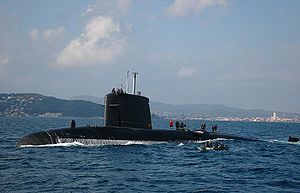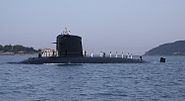| Rubis-class submarine | |
|---|---|
 The Casabianca | |
| Class overview | |
| Name: | Rubis |
| Builders: | DCNS |
| Operators: |
|
| Preceded by: | Daphné class |
| Succeeded by: | Barracuda class |
| In commission: | 23 February 1983 |
| Planned: | 8 |
| Completed: | 6 |
| Cancelled: |
S607 Turquoise |
| Active: |
S601 Rubis (ex-Provence) |
| General characteristics | |
| Type: | nuclear attack submarine |
| Displacement: |
2400 t (surfaced) 2600 t (submerged) |
| Length: | 73.6 m |
| Beam: | 7.6 m |
| Draught: | 6.4 m |
| Propulsion: |
Pressurised water K48 nuclear reactor (48MW) ; 2 turbo-alternators ; 1 electric engine (7 MW); one propeller 1 diesels-alternators SEMT Pielstick 8 PA 4V 185 SM - one auxiliary engine, 5 MW. |
| Speed: | over 25 knots (46 km/h) |
| Range: | Unlimited distance; 20–25 years |
| Complement: |
10 officers |
| Sensors and processing systems: |
DMUX 20 active/passive sonar |
| Armament: |
[1] Anti-submarine : 4 x 533mm tubes.
|
The Rubis type is a class of first-generation nuclear attack submarines of the French Navy. They are the most compact nuclear attack submarines to date. All submarines of the class (except for Casabianca) are named after gemstones.
History[]
Although the Rubis belonged to the same generation as the Redoutable class, due to President Charles De Gaulle's insistence on acquiring a nuclear deterrent for France, the Rubis program was started only in 1974, after the ballistic missile submarine program. The first Rubis hull was laid down in December 1976 and launched in 1979. In 1987, the Canadian White Paper on Defence recommended the purchase of 10 to 12 Rubis or Trafalgar class submarines under technology transfer.[2] with the choice of the type of submarine due to be confirmed before Summer 1988.[3] The goal was to build up a three-ocean navy and to assert Canadian sovereignty over Arctic waters.[4] The purchase was finally abandoned in April 1989.
AMETHYSTE Rebuild[]
The initial design of the Rubis proved to be problematic with unexpectedly high noise levels. This led to the Améthyste silencing program (AMÉlioration Tactique HYdrodynamique Silence Transmission Ecoute) which was applied to the fifth (S605 Améthyste) and sixth (S606 Perle) hulls.
The Améthyste and Perle were both longer that the original Rubis, 73.6 metres as compared with 72 metres and the program included upgrades to the sonar, reshaping of the hull form and bow to improve silencing and additional upgrades of the electronics. With the upgrades tested and proven, the original 4 boats were rebuilt to the same standards between 1989 to 1995.
Operational history[]
During the Péan inter-allied manoeuvres of 1998, Casabianca managed to "sink" the USS Eisenhower and her Ticonderoga class escort cruiser[5]
Design[]
They have a central computer system for submarine detection, processing of information, and firing of weapons. The hull is made of 80 HLES high elasticity steel. The sonar dome and the conning tower are made of composite materials. The submarines have two crews, "Blue" and "Red", who man the ships every three months in turn.
They will be succeeded by the 2nd-generation Barracuda class.
Accidents[]
- S601 Rubis : 20 August 1993 - Collision with oil tanker Lyria[6]
- S604 Émeraude : 30 March 1994 - Steam leaked, 10 casualties.
Photographs[]
| Wikimedia Commons has media related to Rubis class submarine. |
References[]
- ↑ http://www.naval-technology.com/projects/rubis/
- ↑ Challenge and Commitment: A Defence Policy for Canada. Ottawa: Department of National Defence (Canada). 1987. pp. 89. ISBN 978-0-660-12509-1. Archived from the original on 8 December 2008. http://web.archive.org/web/20081208002905/http://www.forces.gc.ca/admpol/downloads/Challenge%20and%20Commitment%201987.pdf. Retrieved 10 June 2010.
- ↑ Defence Update 1988-89. Ottawa: Department of National Defence (Canada). 1989. ISBN 0-662-55733-6. Archived from the original on 11 December 2008. http://web.archive.org/web/20081211092822/http://www.forces.gc.ca/admpol/downloads/Defence%20Update%201988-89.pdf. Retrieved 10 June 2010.
- ↑ Keith Spicer (10 September 2007). "Canada's Arctic claims". http://www.canada.com/ottawacitizen/story.html?id=06b557bc-bbc0-4543-90e3-4da70001bef6.
- ↑ Sous-marin nucléaire d'attaque Casabianca, netmarine.net
- ↑ Simons, Marlis (August 1993). "Oil Spills as Nuclear Sub Hits a Tanker Off France". http://query.nytimes.com/gst/fullpage.html?res=9F0CE0DB123FF933A1575BC0A965958260. Retrieved 2008-06-14.
External links[]
| |||||||||||
| ||||||||||||||||||||
The original article can be found at Rubis-class submarine and the edit history here.







